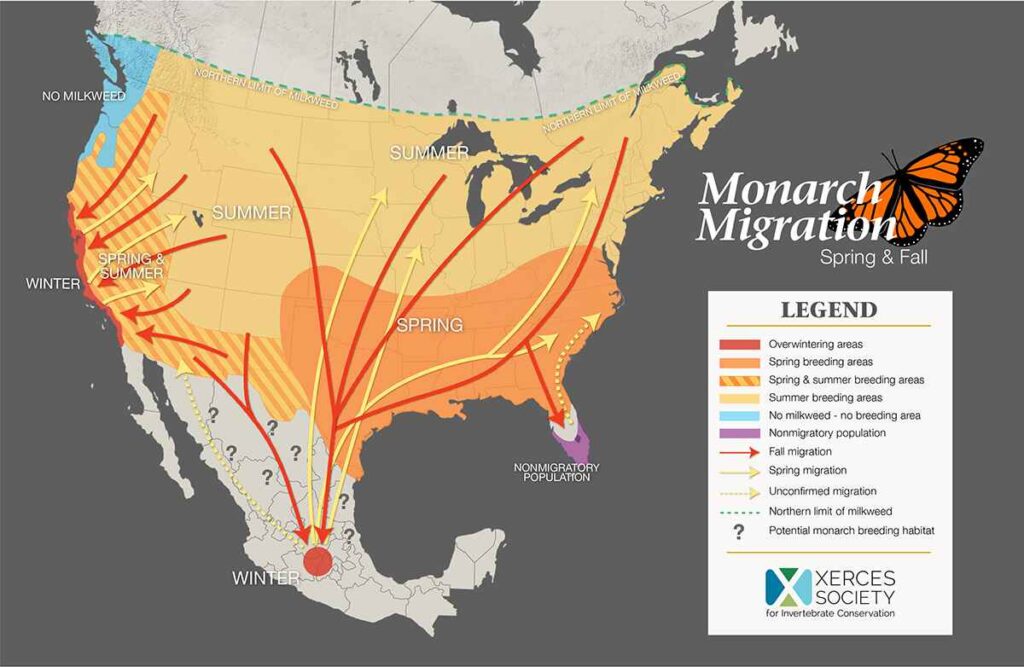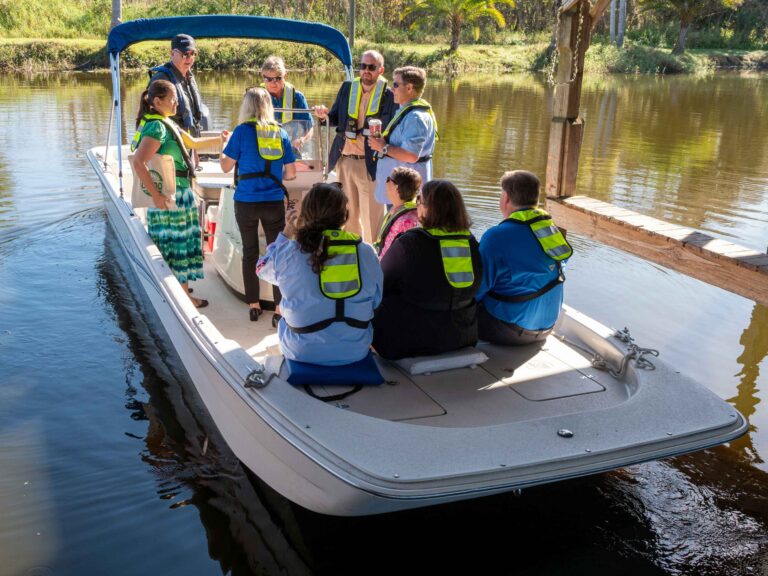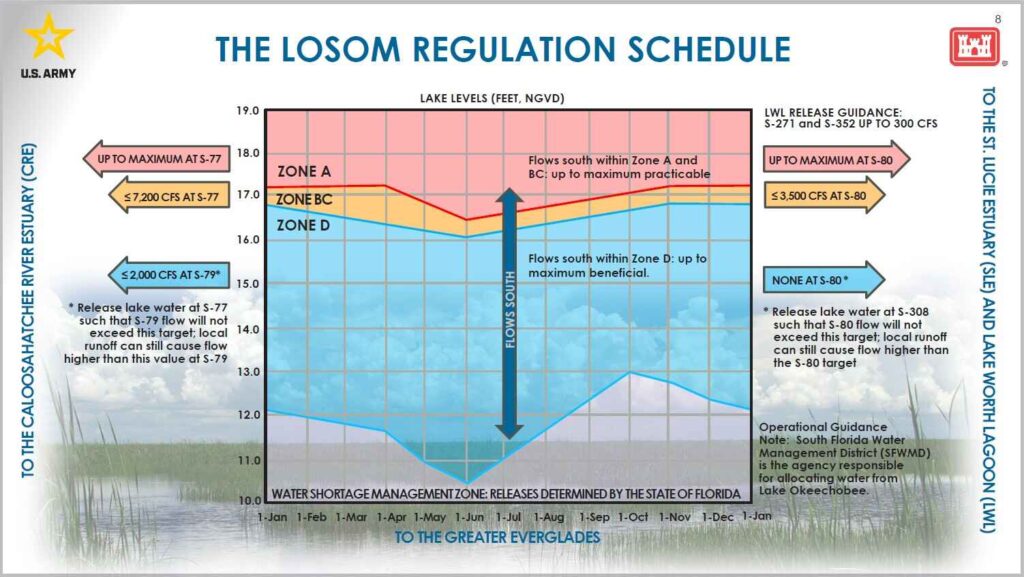By MALLORY LIZANA

With their striking orange and black wings, monarch butterflies are iconic in the insect world and serve as symbols of conservation. Monarchs play a crucial role in pollination, thriving on milkweed, where they lay eggs and their caterpillars feed. After developing through the cocoon phase, monarchs begin their remarkable two-way migration, guided by environmental cues as the weather turns cold, making them the only butterflies to undertake this journey, which for monarchs is to the north and east. However, looming threats may suggest the species could be teetering on the brink of extinction.
According to the Center for Biological Diversity, monarchs numbered more than 1 million in the 1990s before nearly going extinct in 2020. By 2022, experts estimated nearly 250,000 are still in existence. Several studies by wildlife groups suggest that numbers declined again in 2024, based on observations throughout the United States and Mexico.

The decline of monarch populations is compounded by several critical threats, such as habitat loss. Pesticides and herbicides from agriculture, primary drivers of habitat changes, have posed a significant danger, with insecticides—particularly neonicotinoids (neonics)—being the most widely used across the agriculture industry. While neonics effectively eliminate pests, they often have unintended consequences, impacting not only the targeted pests, but also affecting other species such as monarchs and other pollinators.
Neonics stay active in the soil for years when they are applied and can be carried away through waterways, causing widespread destruction well beyond their intended use. These pesticides not only can affect monarchs directly, but can also jeopardize their primary food source: milkweed. Herbicides such as glyphosate have significantly damaged milkweed populations, even leading to its complete eradication in certain areas, depriving monarchs of a crucial host plant and nectar source.
Urbanization poses a persistent threat to monarchs, as rapid development encroaches on their habitats, leading to the loss of open spaces and resources like milkweed. In the southeastern United States, urban sprawl has notably reduced available monarch habitats. Increased tourism and development near critical migratory stopover sites can further exacerbate habitat loss and pollution.
Monarchs rely on environmental cues to time their migrations which make them vulnerable to environmental shifts, including climate change. While their hardiness from experience in different weathered regions remains on their side, temperature changes could still have negative impacts on milkweed, necessitating monarchs to seek new areas.
In Florida, conservation efforts have gained momentum in recent years. Florida’s strategic position as a migratory stopover for monarchs makes it an essential area for conservation. The Florida Fish and Wildlife Conservation Commission has been working closely with local communities and environmental groups to establish monarch-friendly habitats.
Alongside efforts like those seen in Texas and other southeastern states, Florida has increased educational campaigns to reduce pesticide use and promote native plants in urban gardens. Local governments have started passing ordinances to protect pollinator habitats, and state programs now offer incentives for landowners who create monarch waystations and maintain butterfly-friendly landscapes.
While monarch protection remains mainly at the state level, there was a federal act proposed in 2023 that really put the species on the map: The Monarch Action, Recovery, and Conservation of Habitat (MONARCH) Act. This act aimed to protect and restore the natural habitats of western monarch butterflies on a scale that exceeds state borders. It was originally introduced in the House by U.S. Representative Jimmy Panetta (D-CA) and in the Senate by U.S. Senator Jeff Merkley (D-OR).
The MONARCH Act was written to authorize $62.5 million for conservation projects and an additional $62.5 million to implement the Western Monarch Butterfly Conservation Plan, a 50-year strategy to protect western monarch populations. The bills didn’t advance in either chamber.
Wildlife advocates are concerned about the adequacy of the proposed funding to effectively tackle climate change and the decline of pollinator habitats. One key issue is whether the resources will be equitably distributed across the vast seven-state region in the western United States where monarch populations are declining. Additionally, if reintroduced, the bill is likely to encounter opposition from industries, particularly agriculture and pesticide companies, which could experience economic losses and disruptions due to the proposed regulations. Another challenge is striking the right balance between state and federal control in conservation efforts to meet regional needs, but if these challenges are effectively addressed, the MONARCH Act could achieve significant success, if adopted.
The interconnectedness between monarch conservation and broader ecological health underscores the vital importance of protective measures to counteract habitat loss, and there are various ways to make a difference. Key steps include implementing stricter regulations on pesticides, especially neonicotinoids, and adopting pollinator-friendly farming practices. Urban areas can incorporate monarch-friendly habitats, and can be supported by incentives, such as tax breaks and educational grants for community gardens. Initiatives on public lands can model monarch-friendly urban planning and encourage community involvement, which can be further supported by awards and public recognition.
Public lands in Florida and the southeastern U.S. can serve as models for monarch-friendly planning, while national collaboration and education can foster community involvement. The elimination of monarchs would have profound effects on ecosystems, as these butterflies are crucial pollinators and herbivores. Their decline disrupts the intricate interdependencies within ecosystems, causing imbalances that affect overall environmental health. Protecting monarchs— and all pollinators—is vital for the health of shared ecosystems.
Mallory Lizana, Esq., is an Animal Law LL.M. Candidate 2024, at Lewis & Clark Law
























